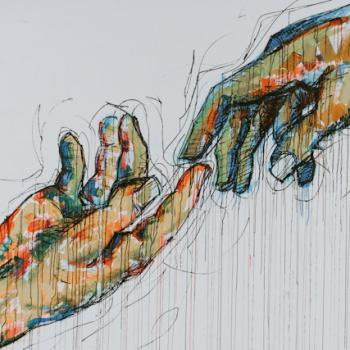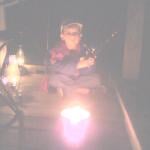
Every bit as much poet as physicist, Einstein once wrote, “We are slowed down sound and light waves, a walking bundle of frequencies tuned into the cosmos. We are souls dressed up in sacred biochemical garments, and our bodies are the instruments through which our souls play their music.”
The Light of Faith
As much as the study of light has been revolutionary in science, it’s been even more transformative in the realm of faith. According to the Hebrew Scriptures, the very first thing God is described as creating is light. The opening lines of Genesis are all about this first creative act. “In the beginning, when God created the heavens and the earth and the earth was without form or shape, with darkness over the abyss and a mighty wind sweeping over the waters— Then God said: Let there be light, and there was light. God saw that the light was good. God then separated the light from the darkness” (1-4).
Then in the Christian Scriptures, Jesus refers to himself as the “light of the world” in John 8 and 9. And in Matthew 5, Jesus tells his disciples that they too are the light of the world (14). Throughout the rest of the New Testament, light remains a central metaphor for explaining what Jesus has done for us. In his letter to the Ephesians, Paul writes, “. . . at one time you were darkness, but now you are light in the Lord” (5: 7-8). Similarly, in his first letter to the Thessalonians, he writes, “But you are not in darkness, brothers and sisters . . . . For you are all children of light, children of the day” 5: (2-4).
Clearly, light is a big deal. A very big deal.
Cave Dwelling
Have you ever taken a tour of a cave system? The tour guide might have explained that it was created when rainwater picked up carbon dioxide in the air whose acidic properties cut into limestone slowly, gradually, but irrevocably over the passage of time. He or she may have pointed out the stalactites and stalagmites as well as the families of bats hiding in various nooks and crannies. But perhaps the most interesting part of the tour was when the guide turned off all the electrical lights that had been run throughout the cave leaving you and your fellow spelunkers in true darkness.
It only lasts a short moment, but it’s a darkness unlike any we experience above ground. At night, the stars and streetlights and our neighbor’s annoying TV on the back porch all make the relative darkness of night far less dark. Experiencing true cave-darkness though is quite another experience. It’s an other-worldly vacuum that seems to have a weight and heft of its own. It’s the optical equivalent of wearing a wool coat soaked through from being left out in the rain for hours but worn anyway. And the transition from modest electric light to cave-darkness gives the pupils in our eyes a workout beyond anything they experience at the gym.
Light transforms everything. It’s no wonder then that the gospels include six references to Jesus giving sight to the blind, at least three of which appear to be entirely separate incidents. This Sunday’s gospel reading is one of them. A blind man named Bartimaeus calls out to Jesus asking for pity. His apostles, who frequently see their role more as security at a concert rather than disciples of a teacher, tell him to back off. But Jesus told them to hush and called Bartimaeus over. Jesus directly asks him what he wants, and he replies, “I want to see.” Jesus heals his blindness proclaiming that “your faith has saved you” (Mark 10: 51-52).
It’s All About Sight
We all want to see. We all want to escape the cave-darkness of a life without meaning or purpose. We all want to have a vision of ourselves, our world, and our God that makes sense, that we can trust.
Physicists find light fascinating in and of itself. It’s the fastest entity in the universe, traveling over 186,000 miles per second, and crazy as it sounds – it takes just over eight minutes for the light from the sun to reach earth. All that’s well and good, but the rest of us value light less because of what it is and more because of what it does. It allows us to see. Mind blown.
For me, faith is all about sight. We can see our fellow humans as competitors for earth’s finite resources in a zero-sum universe or as partners on a journey in a universe of infinite possibility. We can see suffering as a punishment for our sins or as a part of the fabric of the universe that can lead to transformation. We can see death as the cold, final chapter of life’s narrative or as a mysterious threshold through which we are able to experience life in a new way.
We are Bartimaeus. All of us. We are all desperate to see. The life and death and teachings of Jesus are the light that helps us see a world of possibility despite the pain, a life of meaning despite the messiness. Mind blown.
Photo by Yeshi Kangrang on Unsplash











